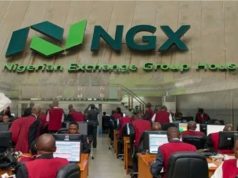SAT 03 JULY, 2021-theGBJournal- Research analyst, Cordros Research say they expect demand for cement to remain healthy in the second half of the year as the full reopening of the economy should enable construction companies to accelerate activities.
‘’We are optimistic about public sector demand as the general moderation in infection rates and reduced spending on the healthcare sector should enhance expenditure on capital projects.’’
On the other hand, they expect the momentum in private sector demand to slow down, given the increase in lending rates and higher yields on government instruments.
‘’We note that Q3 is traditionally a weak quarter due to heavy rainfalls. Having recorded a growth of 3.9% in 2020, we estimate the cement sector will grow by 4.8% (a 2.1x premium to our GDP forecast of 2.7%) in 2021E. We believe the price increments implemented in Q1-21 will protect margins from the impact of the local currency’s devaluation on energy costs.’’
DANGCEM remains top pick within Cordros coverage universe (TP: NGN255.54) as they expect the group to deliver decent earnings in 2021E with an EPS growth of 6.3%.
We rate the company highly given its market leadership position (market share of 62.1% as of FY 2020), strong distribution network, efficient production techniques and ability to influence market prices in enhancing profitability.
For Lafarge Africa, we maintain our ‘BUY’ recommendation with TP of NGN29.53. We believe LAFARGE’s renewed focus on the Nigerian market and continued gains from its deleveraged balance sheet will support earnings.
Thus, 2021E EPS growth is estimated at 13.4%. Cordros say they have initiated coverage on BUACEMENT, Nigeria’s third-largest cement producer, with a ‘SELL’ rating and a Target Price of NGN44.50.
Meanwhile, the full reopening of the economy and reduced government focus on the healthcare sector have continued to propel the construction sector activities.’
However, subdued macro conditions and improved FI yields appear to have slowed the momentum in private sector demand for cement. Meanwhile, industry players have raised prices to neutralise the negative impact of elevated energy costs on margins following the devaluation of the currency.
Overall, cement companies- DANGCEM (+46.7% y/y), WAPCO (+36.1% y/y) and BUACEMENT (+23.1% y/y) recorded growth in PBT in the first quarter of the year. However, market reaction has not been impressive as the Industrial goods index is down (YTD: -8.1% as of June 29) compared to the ASI (-6.5%).
We expect sustained growth in earnings from our coverage names in the second half of the year.
Cordros view is underpinned by continued growth in the construction sector, led by increased public spending on capital projects, gains from price increases implemented in the first quarter of the year and, cost optimisation initiatives put in place to manage costs and preserve margins.
Modest Volume Expansion, Price Increases Underpin Topline Growth:
DANGCEM (+33.5% y/y), WAPCO (+12.2% y/y) and BUACEMENT (+13.4% y/y) delivered strong top-line growth in the first quarter of the year. Although the industry players continue to benefit from healthy demand for cement following the pickup in activities in the construction sector, we note that price increases also played an important role in the double-digit expansion in the top-line.
For context, DANGCEM’s and BUACEMENT’s price per tonne rose by 9.4% y/y and 9.6% y/y respectively in Q1-21 alone, substantially above the increase in FY 2020. (DANGCEM: 4.5% y/y I BUACEMENT: 5.3% y/y).
The sharp increase in price per tonne is consistent with expectations as stated in our 2020FY outlook. We believe higher input costs associated with US dollar-linked cost items forced the players to raise prices to preserve margins. On volumes, save for DANGCEM that delivered solid growth of 22.2% y/y, the other players lagged – BUACEMENT (+2.5% y/y) and LAFARGE (+0.8% y/y). Based on our discussion with the management of DANGCEM, we understand that the company benefitted immensely from the ramp-up of the new and more efficient Obajana Line 5.
Interestingly, management further noted that the company had to suspend clinker exports to meet the rapidly growing local demand.
Sustained Recovery in Construction and Real estate Sectors:
Activities in the real estate sectors extended the recovery that kicked off in Q4-20 to the first quarter of the year. According to data published by NBS, the construction sector grew by 1.4% in Q1-21 (Q4-20: 1.2%), while growth in the real estate sector slowed to 1.8% in Q1-21 (Q4-20: 2.8%). We believe the stronger growth in the construction sector reflects improved public spending on capital projects.
In addition, our market survey, particularly in the South West region, indicates that most states governments ramped up the completion of projects abandoned in the prior year. On the other hand, the slower growth in the real estate sector may be an early indication that the robust private sector demand for housing aided by the low-interest-rate environment may be cooling off given the rise in FI yields during the quarter.
Though we think it is too early to draw this conclusion, we believe future data will provide more evidence on the extent to which the uptick in yields on risk-free instruments has impacted private sector demand for real estate assets. That said, we think the price increments (stated above) implemented by the industry players must have exerted downward pressure on private sector demand for cement.
Price Increases Shields Margin from Rising Energy Cost: Despite grappling with input cost pressures emanating from the impact of the naira devaluation on FCY costs, the impact on margins was neutered by the price increases (as mentioned earlier). As a result, EBITDA margin strengthened across the board in Q1-21 with DANGCEM (+830bps y/y to 65.9%) recording the highest growth, followed by BUACEMENT (+300bps y/y to 47.6%), and LAFARGE (+62bps y/y to 30.9%).
To put things in perspective, we note that the rise in energy cost outpaced the growth in volumes for BUACEMENT (11.9% y/y vs 3.5% y/y) in Q1-21. The reverse the case for DANGCEM as energy cost for Nigeria operations (+9.4% y/y) grew slower than volumes (+22.2% y/y) in Q1-20. Management attributed this to energy efficiency associated with its recently launched Obajana Line 5. There was no breakdown for LAFARGE on variable cost (+14.5% y/y), which was substantially above the marginal growth in volumes (+0.8% y/y) in Q1-20.- Analysis is provided by Cordros Research.
Twitter-@theGBJournal|Facebook-The Government and Business Journal|email: govandbusinessj@gmail.com









